Today we live in a world where everything has become automatic while manual efforts have become minimal. Autonomous vehicle technology is one such concept that is currently being explored in its essence. Recently, a rail transportation company in China called CRRC introduced a train that runs on road instead of tracks. This is the first train in the world that does not need tracks to travel; instead, it uses virtual dotted lines on the road for traffic.
The technology was called ART, i.e. Autonomous Rail Transit, while the vehicle was labeled as “Intelligent Bus” by CRRC. It is a 30 meter long bus, electrically operated and equipped with sensors that follow the virtual road tracks and adapt to the environment and situations in real time.
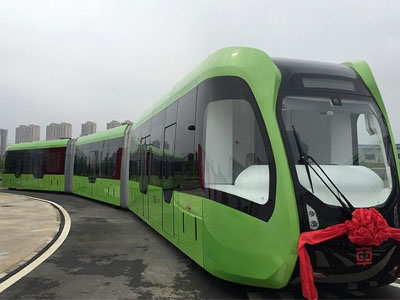
CRRC introduces world's first driverless rail transport in China (image courtesy: Designboom)
Design concept
CRRC, a Chinese rail car manufacturer, recently unveiled a combined bus-rail transit system in Zhuzhou, Hunan province. Chinese Rail Corporation started designing this system in 2013 and now finally in June 2017 the system has been successfully tested.
Cost
In addition to being fast, this trackless transit is highly economical in terms of construction. It takes 400-700 million Yuan, that is, 58-102 million dollars to build one kilometer of metro, while trams have a development cost of about 150-200 million Yuan per km.
However, the ART, that is, the Autonomous Rail Rapid Transit, will cost one fifth of the cost of a conventional metro. According to reports, a standard-length ART bus can be built with just 15 million Yuan, that is, 2.2 million dollars or even less.
Exteriors
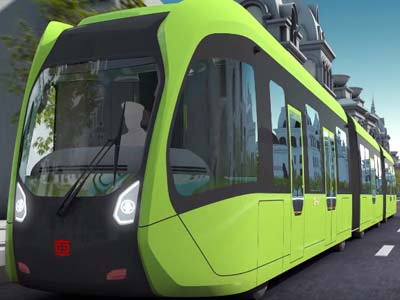
Animated representation of China's autonomous rail transit (image courtesy: YouTube)
This vehicle developed by CRRC is a bus and train hybrid with a certain similarity to a tram. It is equipped with rubber wheels and travels on the road like a normal bus, with greater load capacity. Vehicle cars can be changed by adding or removing cars depending on the need.
Dimensionally, it is 3.4 meters high, 2.65 meters wide and 31.64 meters long. Furthermore, it has a safe channel width of 3.83 meters and a minimum turning radius of 15 meters, which provides flexibility in its movements, especially when cornering. An important aspect of its design is that the body structure of this smart bus has a long service life of more than 25 years, which implies economic viability.
Interiors
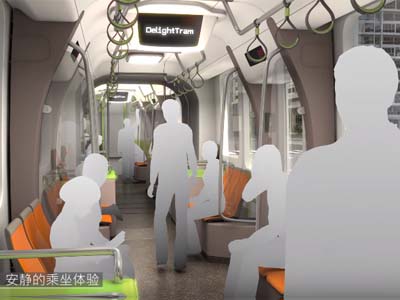
Animated presentation of ART's internal layout (image courtesy: YouTube)
Moving on to the interior of the smart bus, there is plenty of space with a capacity for 307 passengers. A unique feature of the vehicle is that its cars are removable, thus allowing the flexibility to add or remove cars as needed.
In addition, there are priority seats for babies and mothers, as well as adequate space for passengers in wheelchairs. From the inside, it looks like a subway equipped with digital displays, comfortable seats and adequate space.
Main features
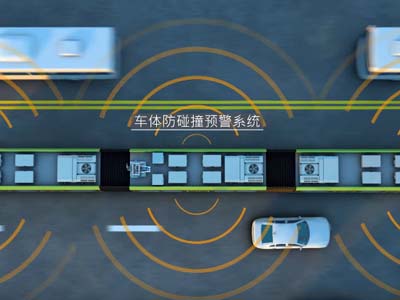
China Autonomous Rail Transit Equipped Collision Warning System
(Image courtesy: YouTube)
Like any other autonomous vehicle, this transit features advanced features that, in turn, reduce manual effort on the part of the driver. These functions include:
Lane departure warning system
This system helps guide the vehicle to continue driving on the track and warns whenever it deviates from the track.
Electronic Rear View Mirror
These types of rear view mirrors are electrically adjustable and provide a clearer view. Additionally, they are also equipped with auto-dimming technology to reduce glare.
Collision warning system
Collision warning helps the driver maintain a safe distance from other vehicles on the road and whenever the proximity decreases, it displays a warning sign.
Route change authorization
The navigation feature equipped with the vehicle can analyze the route it is traveling and redirect to a different route in order to avoid traffic congestion.
Other advantages
• No physical transit limit, allowing flexible operations
• Intelligent signal communication and control for priority passage
• Multi-axis steering system
• Trackless autonomous traction
• Low construction cost and ecological
Mechanics
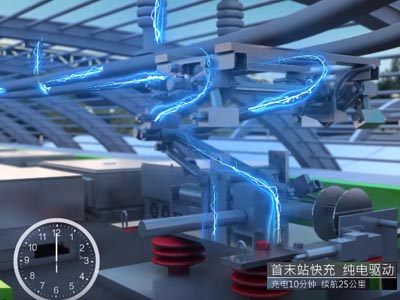
Pictorial representation of ART's flash charging terminal (image courtesy: YouTube)
As it is an autonomous and fully electric vehicle, the role of the powertrain is played by batteries. The smart bus is equipped with lithium titanate batteries and has a flash charging feature that allows the trackless train to travel more than 25 km i.e. 15 miles in just 10 minutes of charging. Furthermore, on a full charge, the vehicle can travel up to 40kms. As far as maximum speed is concerned, the autonomous train's speedometer needle can exceed 43 mph or 70 km/h.
Implementation
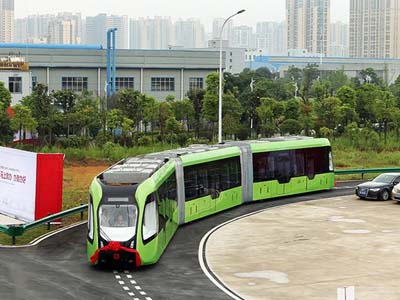
China's autonomous rail rapid transit being tested in Zhuzhou (image courtesy: boredpanda )
Automated Rail Transit is a non-polluting, trackless and driverless vehicle that is expected to reduce traffic congestion in China's highly populated cities. The transit is expected to be implemented in Zhuzhou by the year 2018, with a total length of 6.5 km. Upon completion, it will dock with the city's medium-low speed maglev train.
If everything goes according to plan, this train could become a huge success in the coming years. Due to its low development cost and large carrying capacity, China's road congestion can be significantly reduced. Furthermore, the vehicle is not only environmentally friendly but can also withstand various types of weather conditions.
All of the above factors make CRRC's ART an ideal system for transit from the suburbs to the city center. However, it is too early to say to what extent China's technology would be boosted by this smart hybrid bus.
You can read our Blog and Article section for more topics on electronic engineering, industry and technology.

